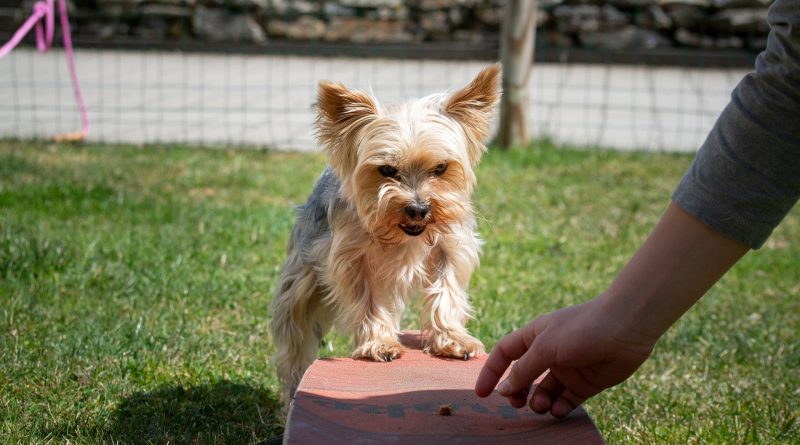Tips for Training with Food Rewards
Positive reinforcement training is widely accepted as an ideal way to train our pets. However, for many pets, the easiest reward tends to be food, which can cause issues. Many ‘high value’ treats can also be high calorie and either unbalance your pet’s diet or add too many calories. Positive reinforcement training doesn’t have to mean extra calories and can be done creatively, even in pets needing to watch the calories.
Step 1: Find what is rewarding for your pet
Positive training can utilize more than just food rewards! For example, many search and rescue dogs work for a favorite toy. Try to find a couple of non-food things that your dog gets excited about. Here are some questions to help you figure out what might be rewarding.
- Do they get excited when you pick up the leash to go for a walk?
- Do they like a particular toy, ball, or just love playing with sticks outside?
- Do they perk up to their name or look happy when you just talk to them?
- Do they enjoy getting scratched in a particular spot?
Make a list of these rewarding things and try to rank them from most to least rewarding.
Step 2: Assess the food rewards
Food rewards are not out of the picture for most pets, but there should be some thought and intention put into them. Some pets will never be more motivated than when food is offered. Foods should also be ranked on the reward list. Your pet’s regular diet should be ranked on the list as well. If your pet is particularly food motivated, their regular diet may rank high on their reward list – just be sure to subtract the amount you give in treats from their daily allotment.
Instead of commonly used treats like hot dogs, deli meats, cheese, etc., try to first experiment with low calorie foods such as small pieces of fruits and vegetables like crunchy cucumbers or blueberries (see our previous article on healthy treat options for more ideas). Find the smallest commercial dog treats and then see if they can be broken up into tiny pieces – your dog is excited about the treat and will like a 1/2 inch or a 2 inch treat! Remember, anything that is not their main balanced diet should add up to be less than 10% of their daily calorie intake on average. If you train heavily on one day, it’s ok to go over 10% that one day, but then adjust the treats on the other days to even this out so it’s 10% on average throughout the week.
Step 3: Reconsider the food bowl
Meals fed in a bowl are a convenience for us, however wolfing down the food all at once does not make the food taste better to our pets and can result in health issues as well. Making meal times a training session can make their meals safer, slower, and more fun. For pets that are not motivated to train with their regular diet, this may increase their motivation for it. If they know they will get it for free later, why work for it? If they are still uninterested in their food sometimes switching to a different diet can increase their interest, but always speak with your veterinarian if you are unsure about changing your pet’s diet.
Step 4: Set up a daily allotment
Make sure you are keeping to the correct caloric intake for your pet’s needs. Anything that goes past their lips should be counted in this daily calorie intake. Set up their daily ration at the beginning of the day, then anyone in the household is free to dispense from it throughout the day. This is a good way to make sure they aren’t sneaking extras through the day and keep everyone in the household on the same page.
Step 5: Mix it up!
Variety can help keep things interesting. Mixing up what the reward is makes even the lower ranked rewards more exciting. This behavior is well studied – just think about a human in a casino, they don’t hit the jackpot every time but some play like they will. In one training session reward with cucumber, chicken, kibble, and the throwing of a toy so you can continue to keep your pet’s attention. Another powerful training tool is intermittent reinforcement. Once your pet learns a behavior you no longer have to reward for it every time. Surprising them with when and what they will be rewarded makes training extra fun as they will never know when they will hit the jackpot!
Step 6: Find active ways to train
Minding calories is only half of keeping your pet at a healthy weight. Increasing exercise can be just as important for their health. Working on behaviors out on a walk or throwing the treat so they have to get it from the opposite side of the room can be ways to keep training active.
Step 7: Keep training sessions short and fun!
Training is most effective in short bursts. Keeping training sessions short will not only help you fit them into your schedule but keep your pet’s enthusiasm high. Always end on a positive note and you will be surprised at how much they will improve between sessions.
Training is a great way to teach tricks and manners, but most importantly increases the human-animal bond. Using these tips can ensure positive training progress without any harm to your pet’s nutrient intake or waistline!
Written in conjunction with veterinary student Emily Peterson.

